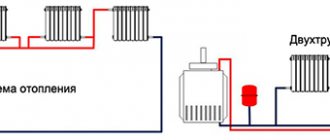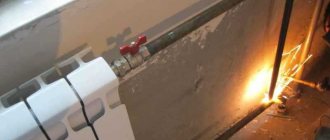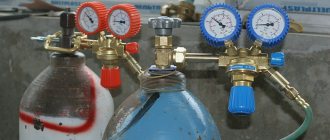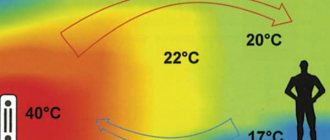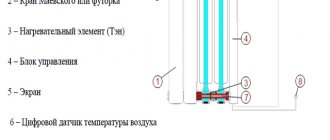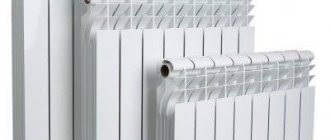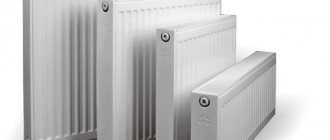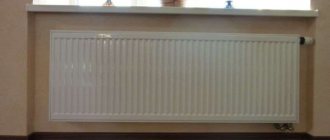Single pipe heating
A single-pipe heating system is the simplest and cheapest design to install. This wiring scheme is usually used in multi-apartment buildings, but it is also sometimes found in private houses. In a one-pipe system, radiators are installed according to a series connection scheme, i.e. The coolant passes through the heating devices one by one. From the last radiator, the cooled coolant returns to the heating boiler or riser.
The key disadvantage of the single-pipe scheme is the uneven heating of the installed radiators and the inability to control their heat transfer. Installing a regulator on one battery leads to adjustment of a further section of the circuit. Batteries located far from the boiler receive much less heat - it simply remains on the previous devices. Even if you know exactly how to connect the battery correctly, uniform heat transfer in a single-pipe system cannot be achieved.
Two-pipe heating
A distinctive feature of two-pipe wiring is the presence of two circuits, one of which is designed to supply heated coolant to the radiators, and the second is necessary to return the cooled coolant to the boiler. The two-pipe design makes it possible to connect radiators in parallel, as a result of which each of them receives coolant at the same temperature.
Thanks to the parallel connection, it is possible to achieve independence for each radiator, therefore it is possible to install separate thermostats on them to adjust the heat transfer. The only drawback of such wiring is the high cost - twice as much materials are required to install heating. However, these costs will more than pay off in the future.
Radiator location
In the vast majority of cases, radiators are installed under windows, and this location is completely justified. The fact is that there is always a flow of cold air from the windows - and the heated air masses rising from the radiator prevent them from entering the room. In addition, heated air prevents condensation from forming on the glass.
To know exactly how to properly connect a heating battery in an apartment, you need to take into account the following rules and follow them when designing and installing a heating system:
- Normal prevention of cold from entering windows and the formation of condensation on them is only possible if the dimensions of the radiator occupy at least 70% of the width of the window opening. This factor must be taken into account at the stage of selecting radiators.
- It is recommended to install heating radiators at a height of about 10 cm from the floor level. A large deviation from this indicator will lead to insufficient heating of the lower level of the room or will cause difficulties during cleaning. The distance to the window sill should be about 10-12 cm - this value allows the air to freely go around the obstacle and fully warm the window.
- The distance between the battery and the wall should be about 3-5 cm. With this placement, heated air masses freely pass through the space behind the battery, resulting in improved room heating efficiency.
Methods for connecting radiators
There are several options for connecting radiators, but they are all divided into two large categories - side and bottom. The bottom connection can be made in the only way that looks very simple: there are two pipes, one of which is connected to the radiator inlet, and the second to the outlet. The connection diagram for a heating radiator in an apartment is always described in the documentation attached to it.
The side diagram for connecting batteries in an apartment has a greater number of options, including:
- Diagonal connection;
- One-way connection;
- Bottom (saddle) connection.
Each option should be given special attention.
Types of pipe system
In the heating system diagram, the relative position of the coolant supply inlet and the return outlet is of fundamental importance. This depends on the direction of the coolant and the type of pipe system.
Single pipe system
This is a simplified option for arranging heating in a cottage. This option is quite economical, since it requires fewer pipes for wiring and is carried out with less labor for installation work. The system is a chain of radiators connected by one pipe. The coolant heated in the boiler enters each radiator in turn, flowing from one to another. That is, the “return” from one battery becomes the feed for the next, etc.
For single-pipe systems, you can now install special modules Radiplekt and Radiplekt Therm from Gibax, thanks to which you can maintain the temperature in the house using automatic or manual modes. Their installation is quite simple, and the minimum number of connections will provide an additional guarantee for the reliability of the connections.
The single-pipe scheme for connecting heating radiators in a private house has one significant drawback - with it, the radiators heat up unevenly. The first radiator will always be the hottest, and further from battery to battery the temperature will gradually decrease. Therefore, it is impossible to maintain the same temperature in all rooms with single-pipe heating.
Scheme of single-pipe heating of a two-story cottage Source utepleniedoma.com
For certain layout features, a single-pipe system may be quite suitable. So, if in a small house the chain of radiators starts from living rooms and ends with technical rooms, this option may be optimal. But in spacious cottages it is better to install two-pipe heating.
Two-pipe system
A more expensive option to install, but simple and easy to use. In this system, two pipe lines operate simultaneously. The first supplies hot water to each battery. That is, there is one pipe going into each radiator. The coolant, before entering the radiator, regardless of its location in the circuit, does not enter neighboring radiators, but goes directly. The second pipe collects the return from all radiators and delivers it to the heating manifold.
The advantages of the bottom type of wiring are that almost the same temperature is achieved at all heat exchange points. Such a system is better adjustable and ensures uniform heating of the entire building.
Scheme of two-pipe heating of a cottage Source ro.decorexpro.com
Beam (collector) system
The collector circuit is a variant of a two-pipe connection, but with more complex wiring. It is used in cases where it is necessary to hide pipes, for example under a floor covering. In this case, two collectors are installed - for the supply and for the return, and from each radiator one pipe extends into the first collector, and another one into the second.
Some connection schemes use two types of system. The entire house can be heated using the two-pipe principle, but for a separate area, such as a veranda or large living room, a combination of several radiators using the single-pipe principle is used. When developing a two-pipe scheme for connecting heating radiators in a private house, the main thing is not to get confused in the supply and return manifolds.
Radial (collector) heating circuit Source firmacz.ru
Diagonal connection
The diagonal diagram for connecting heating batteries in an apartment is considered the most effective, so if possible, you should give preference to it. Most manufacturers of heating devices check their products with a diagonal connection, and in accordance with the information received, they enter data into the technical data sheet of the radiators.
With a diagonal connection, the heated coolant is launched through the upper inlet on one side of the battery. Having completely passed through the radiator, the cooled coolant is directed to the outlet pipe, which is located on the other side of the battery in its lower part. As a result, the diagonal connection of the radiator in the apartment ensures maximum coolant passage through the internal cavities of the heating device.
One way bottom top connection
Mainly used in multi-storey buildings. In cottages with 2 or 3 floors with single-pipe heating, it is also sometimes used. The difference between the lower and upper connections is that in the first case, hot water is supplied to the lower inlet and discharged under pressure through the upper inlet, and in the second case, the opposite happens. In both cases, the plant and coolant outlet are located on one side. It is worth noting that of all the existing options, the one-way bottom connection is the most ineffective.
One way connection
This radiator connection diagram fully lives up to its name - the supply and return pipes are connected to the device from one side, but at different levels. This option is most relevant in apartments where the riser is located on the side of the radiator. In other situations, a one-way connection will not be very convenient to install.
The efficiency of a one-way connection is quite high and is only slightly inferior to a diagonal one. This statement is true if the number of sections does not exceed 10 - a battery that is too long will not warm up completely, so heat transfer will decrease. In panel, aluminum and bimetallic radiators, this problem can be solved by using flow extenders, which allow the coolant to pass through a larger part of the radiator.
Types of coolant circulation and connection options
The coolant, which in most cases is water, can circulate in the heating system in two ways - forced and natural. Forced circulation implies the presence of a special pump in the heating system, through which the coolant is moved. The pump can be an element of the heating boiler (that is, it is built inside) or it can be installed directly in front of the heating boiler - on the return pipe. When developing a connection diagram for heating batteries, the location for the pump must be correctly determined in advance.
A system with natural circulation of the medium is an excellent solution for those homes that often experience power outages. The movement of the coolant is based on elementary laws of physics. In such a system, the boiler is non-volatile.
In many ways, the types of connections for heating radiators depend not only on the type of coolant circulation. In addition, it is also necessary to take into account the duration of the system pipes and the peculiarities of their location.
One way connection
This type of radiator connection assumes that both the hot coolant supply pipe and the return pipe will be connected to one side of the battery. Using this connection principle is the most rational for one-story houses. It is especially suitable if you plan to connect fairly long radiators - up to 14-15 sections. However, if the number of sections is more than 15, the heating efficiency may decrease - that is, the last sections of the radiator will be colder than those closer to the pipes. Therefore, in this case, you should choose other options for connecting heating radiators.
One way connection
Saddle and bottom connection
This connection is suitable for those systems whose pipes are installed under the floor surface. In this case, there will be only a small section of pipe above the surface, which is connected to the lower pipe. In this case, the inlet pipe is mounted on one side of the radiator, and the outlet pipe on the other. The disadvantage of this connection method is significant (up to 15%) heat loss. In the upper part, the radiator may not warm up completely.
Bottom connection
Diagonal (cross) connection
Diagonal connection of heating radiators is best used for radiators with a large number of sections. The design of the radiator allows the coolant to be distributed within the sections as evenly as possible - this makes it possible to obtain maximum heat transfer. The essence of the connection is simple - the heated coolant supply pipe is connected to the upper branch pipe. And a return pipe is connected to the lower pipe on the other side of the radiator. The advantage of this type of connection is minimal heat loss - it is only 2%.
Diagonal (cross) connection
The quality of heating the room will depend on how correctly you determine how to connect radiators to your heating system. The proposed options for connecting heating batteries are extremely simple and of the highest quality.
Bottom connection
This connection option is characterized by minimal efficiency - the heat transfer of radiators when used is reduced by an average of 12%. However, in some situations these losses will be justified, since the bottom connection allows you to install pipes as discreetly as possible, thereby improving the interior of the room. And heat loss can be compensated for by a more powerful radiator.
In gravity heating systems, it is not recommended to use a saddle-type connection due to its insufficient efficiency. If the heating system has a pump, then the system will work quite well and the heat transfer of the heating devices will increase. This is partly due to the little-studied vortex nature of the coolant flow, in which heat transfer is characterized as the most intense.
Parallel connection of heating radiators (one-sided circuit)
Not a very efficient connection, since the radiator does not fully warm up.
This is especially true when the radiator is more than one meter in length (panel type), or more than ten sections (bimetal, aluminum). Heat losses are significant. Therefore, when installing large radiators in your apartment, use a diagonal connection. About him below.
